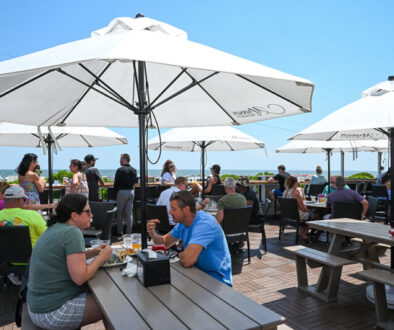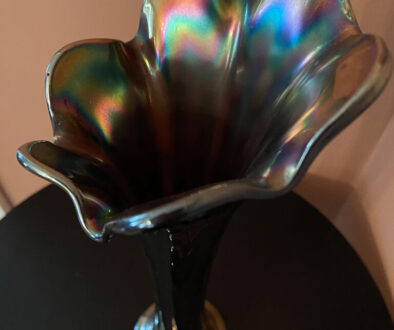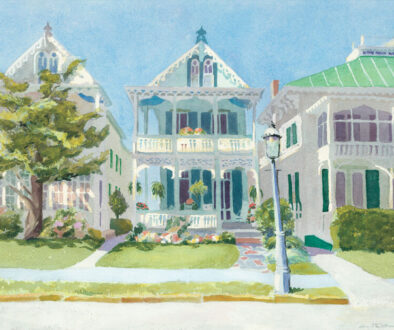It Took a Village
The experiment to turn Cape May into a destination
Once upon a time, government leaders, some local and summer residents, and “out-of-town historians,” had an idea to make Cape May a year-round tourist destination modeled after the Rockefellers’ Colonial Williamsburg. From a one-building beginning in 1932, the Colonial Williamsburg Foundation restored, replicated, and interpreted a growing number of buildings, creating a destination where visitors could experience colonial period history as it had taken place in Virginia settlements. Williamsburg capitalized on the then-popular perspective of history reflecting only the colonial period and interpreted it via living history experiences rather than traditional museum exhibits. By the 1960s, America’s notion of history began expanding to the Victorian Era.

The Cape May Idea: Using the city’s authentic architecture and history, a stable year-round economy could be created by establishing a historical destination, the Victorian Village, based on the country’s newfound love affair with Victoriana. Rather than offering the sole attraction of the beach, interesting displays of Victorian furniture and objects, guided history tours, or other special events could expand the season beyond the summer and entice new visitors to the “Nation’s Oldest Seaside Resort.”
Local citizens met to envision this year-round tourist destination and its potential attractions. The Victorian idea was viewed as better than Colonial Williamsburg because it would be created by the local community, without any big-donor money, as a living history collection of authentic buildings. The number of existing buildings meant that nothing would need to be replicated as occurred in Williamsburg. In fact, The Philadelphia Inquirer quoted David Teel, then Cape May City Manager, as saying that in Cape May, the “locale is original and the structures authentic.” Cape May would create this Victorian destination based on a partnership between the city administration and its residents.
The partnership not only reflected long-standing community values but grew out of 1963 recommendations to stimulate tourist interest in the new Cape May-Lewes Ferry, scheduled to open in the summer of 1964. The primary recommendation was to open a series of living history destinations including fishing, whaling, and farming villages spread throughout the county and a “Victorian styled village in the heart of Cape May.” This same report introduced the idea of possible financing through the federal Urban Renewal program, a unique application of this program where funds were traditionally used in large urban cities to eliminate slums.

After many informal meetings, a group of townspeople founded the not-for-profit Victorian Village Development Corporation. In January 1964, five founding members chartered the Corporation to create and manage themed attractions, some of which would be opened by the summer of 1964. Joining Dr. Irving Tenenbaum as founding members were Bernard Miller, John Head, Robert Kroner, and Alan Lyster. Immediate tasks were to raise money and recruit volunteers to operate attractions. In April, the Corporation began selling shares to local citizens at $5 each and sponsored a large dinner as a fundraiser. Never exactly neutral and often upbeat, the Star and Wave endorsed the project in a March 1964 editorial, saying, “We think the Victorian Villagers need all the help they can get to start this important project to make Cape May City a more attractive, more popular, more prosperous resort, not just for the summer folks but for those who appreciate Victorian charm and want interesting things to do all year. As we have said before, the rejuvenation of the nation’s oldest resort is on its way!”
Townspeople were enthusiastic and supportive of the group and of developing and operating Victorian attractions. The city administration pitched in to market the Victorian Village by placing ads in major city newspapers about the newly established Village attractions. “Yes, here is old-fashioned hospitality at its best. This year bring your family to see the Victorian Village and ride the old-fashioned trolleys,” the Richmond Times advertised in May 1964. Similar advertisements placed in major city newspapers aimed at recruiting people who were not previous visitors.
If these visitors were expecting a defined location like a theme park, they were probably disappointed. The Victorian Village fundamentally consisted of a museum, trolley rides, a few special events, businesses—many of which were adding the label of Victorian to their names—and blocks of the town’s authentic Victorian buildings.

All through the spring, members of the not-for-profit group worked to get attractions up and running in time for summer crowds. The former bank building on Ocean and Washington Streets, today the Christmas shop Winterwood, 60 years ago became the location of the first Victorian Museum and a central attraction of the Victorian Village. Cape May women created three Victorian-themed rooms within the museum. Furniture and objects of Victorian times were sought out for museum display through word-of-mouth and stories in the Star and Wave. Residents went through their attics and homes to donate or loan Victoriana such as rugs, furniture, draperies, pictures, frames, porcelain, and other objects for display in a re-created bedroom and sitting room. Women’s Community Club members took on the responsibility of staffing the museum, dressing in authentic Victorian costumes while serving as docents.
As promised, the widely publicized museum was opened for the 1964 summer season. Inaugurated on Memorial Day with curator and local-architect Greg Ogden, the museum was reported to be the “first in the nation dedicated to perform the heritage of the bygone Victorian Era.” Imagine walking through the double doors of the old bank to a “kaleidoscope of sights including one of the nation’s finest collections of Victorian costumes” as well as many objects, paintings, and other memorabilia. Future expansions to the Museum were planned, including a library with documents related to Cape May’s long history. True to their spirit and dedication to their town’s future, Cape May residents worked together to establish and operate quality attractions to entice people to visit.
The museum was a central attraction, but perhaps even more popular were the guided old-fashioned trolley rides, operated by Victorian Village volunteers. Two operating trolleys replicated those used on Cape May’s streets during the Victorian period—including the horses that pulled them. Constructed according to local reports by a company at the Cape May airport doing similar work for Disneyland and other national customers, trolleys were financed with support of local banks. Special tour leaders guided riders throughout the city to admire the extensive and varied Victorian architectural styles and learn about Cape May’s resort history. The Victorian Village group reported first year results to the City Council in September 1964: 6,000 people rode on the trolleys, and 3,000 visited the museum from May until September. Almost everyone found these results not only positive but a beacon for future economic prosperity. Attractions had successfully drawn new visitors to Cape May.

The horse-drawn trolleys were modernized over the years, first pulled by horses, then tractors, and then eventually replaced by today’s self-contained vehicles. Evening horse and carriage rides eventually joined the trolleys as another attraction. Drivers provided information, as they do today, about the historic homes and hotels while giving visitors a live experience of authentic Victorian-era travel. Many things do not last for very long, so it is amazing to think that 60 years of visitors, close to 400,000, have enjoyed these guided tours throughout our beautiful city streets year after year after year.
Attractions were added each year throughout the 1960s to further enhance visitors’ Victorian experiences. Other groups and organizations joined the Victorian Village group in sponsoring Victorian events. Often involving music or dance, they entertained visitors in locations throughout the city. A Victorian choir, along with several bands, and a Victorian Barbershop group gave regular concerts. Victorian-inspired theater readings and productions were organized. Victorian Week began in July 1966 with a week-long program of themed events such as fashion shows, teas, and lectures. Anything Victorian or about Victorians was welcomed to attract and engage visitors!
Gradually Cape May became a desired destination as more tourists ventured to the tip of Cape May County to see the buildings and participate in the many events—but they came primarily during the summer months, which was largely when the attractions were offered. Even in the 1960s, many of Cape May’s old hotels, boarding houses, and homes were unheated, “summer only” accommodations, and many businesses closed on Labor Day. Not all attractions survived.

You may be wondering, for example, what happened to the first-of-its-kind Victorian Museum, the centerpiece of the Victorian Village, or what became of the historical library? The Victorian Museum was relocated after a few years when the city wanted to sell the building that up until 1962 had housed the local government offices. But, then the building into which the Museum was moved was also sold. Relocating the museum a second time was a challenge. This second, and final, move was to what was called the Hughes Estate, the building next to City Hall, where the Museum lasted until 1971.
The partnership between the Victorian Village Development Corporation and the city was another idea of Dr. Irving Tenenbaum, who remained strongly committed to improving Cape May’s economic future based on its Victorian architecture. Planning discussions creating the Victorian Village occurred at the same time the city was considering use of urban renewal as a funding source for restoring buildings in the Victorian Village, a yet-to-be-identified central business and residential area.
The decision to try to obtain urban renewal funds was not unanimously supported. Cape May citizens were self-sufficient, enterprising, and independent. Accepting funds to build a sea wall following the extreme damage of the 1962 Ash Wednesday storm was one of the first times where town officials tapped into outside funds. Perhaps the magnitude of the town’s problems, exaggerated by the storm damage, created conditions that allowed both residents and government officials to consider participation in federal programs.
While the Victorian Village Development Corporation, managed by local resident volunteers, created Victorian-themed attractions, the urban renewal program, managed by city government, defined the Victorian Village’s physical boundaries and provided funds to rehabilitate buildings and city infrastructure within Village boundaries. The idea was to address “slum conditions” not by demolition but by repair and restoration of the authentic building stock.
In early 1964 as the private Victorian Village Development Corporation began planning the museum and trolley rides, almost simultaneously the first phase of the City’s urban renewal application was approved. The city received initial-phase funding to plan and develop the urban renewal project, also labeled as the Victorian Village. This project was notable locally because, among other benefits, urban renewal dollars provided residents with a reconfiguration of the downtown business blocks into today’s enduring and still-popular pedestrian mall. Dollars also allowed for the city’s aging infrastructure, like sewer and drainage systems, to be replaced and provided building owners with loans and grants to fix up their properties. The urban renewal project attracted significant attention nationally because funds were being used in a small city, not primarily for slum clearance, but for enhancing old historic buildings to build and strengthen the tourist industry. In other words, urban renewal funds were directed to historic preservation.
A first step in the planning grant was to identify what blocks would be included in the proposed Village. Kendree and Shephard, a Philadelphia firm, was hired to complete the planning work. They, in turn, hired Carolyn Pitts, a Philadelphia architectural historian, to propose boundaries for the urban renewal work by surveying each city block to define contiguous blocks with the greatest numbers of properties that could be rehabilitated. In early 1965, the boundaries for the now-named Victorian Village were defined as a 77-acre plot in the central area of town where the city planned to use funds for property repair and restoration and to improve the business district, all in support of establishing a year-round heritage tourism destination.

The tandem work of the Development Corporation and the urban renewal project were both essential and complementary components of the plan to create a Williamsburg-like Victorian Village as a year-round travel destination. However, the city’s government changed, and newly elected officials had different views and perspectives about the role of preservation in enhancing the city’s economic future. Preserving the authentic buildings began to take second place to replacing them with empty lots or, in other instances, with demolition followed by new construction of faux-Victorian design. Many people were up in arms about what was taking place.
By 1971, year-round and summer residents, advocates for the town’s historic properties, and city government officials were in turmoil over the purpose and “look” of the Victorian Village. After a large and contentious battle where the Physick Estate was almost lost, discouraged Victorian Village Development Corporation members, undergoing some of their own disagreements with city administration, lost their enthusiasm and usefulness. The Museum was closed in 1970, when the city once again wanted to sell the property where the Museum was located, but offered no location to which it could be moved. In 1972, the remaining assets of the Corporation reverted to the MidAtlantic Center for the Arts (MAC), newly formed in 1970 to fight for and restore the Physick Estate. The transfer of these assets began MAC’s present-day role as a primary provider of attractions that entertain Cape May visitors and keep them coming back year after year.
The original notion of that Williamsburg-like Victorian Village for year-round visitors never quite materialized. And maybe that was a good thing. The idea was based on two newly emerging concepts of the day: expanding history past the colonial period and creating living history museums. Even though living history museums remain popular ways of interpreting history, all things Victorian pretty much fell out of fashion long ago and, in the case of Cape May city limits, the living history part never got off the ground. While the original Victorian Village urban renewal project was not exactly executed as planned, remnants have survived. Urban renewal dollars and advocacy of many local and national supporters provided the foundation upon which today’s economic success, while not exactly Victorian or living history, is based.
Tourists love the Washington Street pedestrian mall, created totally with urban renewal funds, and they love the old-timey feel of the town, one of the best national collections of rehabilitated properties. They enjoy riding trolleys and horse carriages. On the other hand, the goal of creating a year-round destination was only partly achieved. Cape May is now “open for business” in more ways than some people like, not just for the summer months, but also for Christmas and shoulder weekends during the spring and fall months.
Way back in the 1960s, the seeds of urban renewal funds allowed Cape May’s physical and cultural opportunities to grow into New Jersey’s primary summer resort and a national heritage tourism destination. It took many, many years for this 1960s dream to materialize—but materialize, it did.



